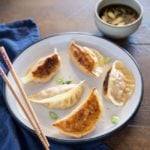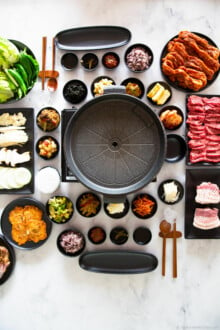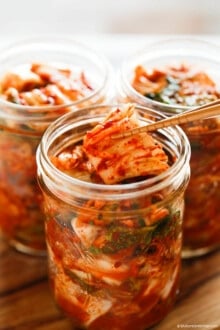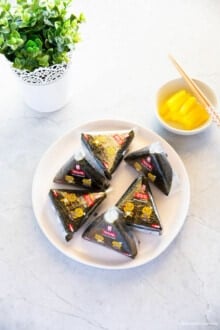Easy and delicious Korean Kimchi Mandu (Kimchi dumplings) recipe. Let’s take a bite!
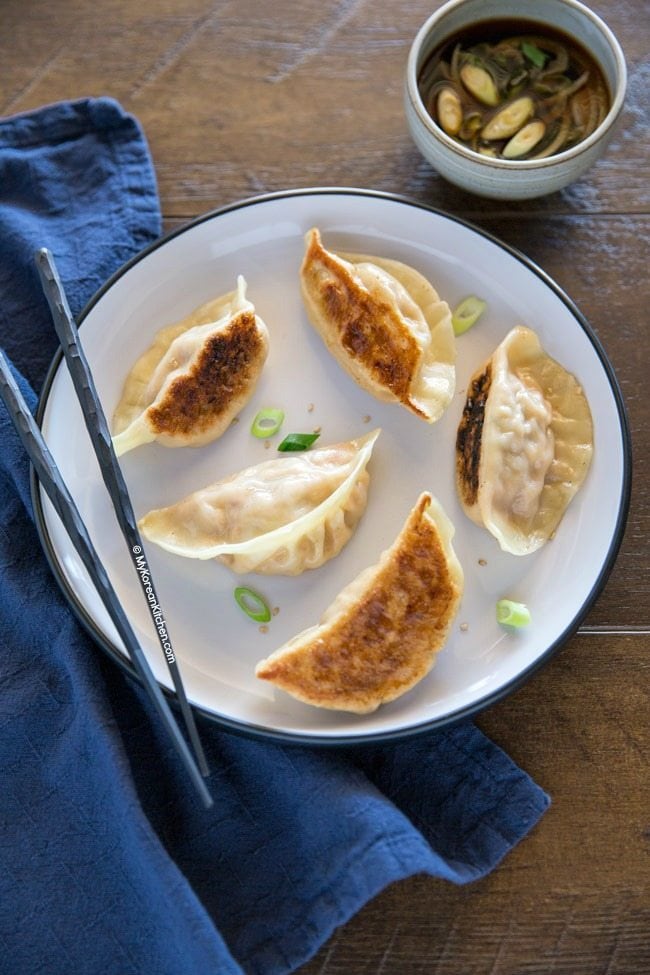
If there is Jiaozi in China and Gyoza in Japan, we have something similar called Mandu / Mandoo (만두) in Korea.
There are many ways of making Korean mandu / Korean dumplings and one of the most popular is Kimchi Mandu (Kimchi Dumplings, 김치만두). A bit too obvious? 🙂
As you can gather, one of the main dumpling fillings here is (napa cabbage) Kimchi. Typically, it’s also packed with minced pork and tofu as well. But these can be easily adapted to your preference.
Mandu can be fried for a crunchy texture (i.e. gun mandu, 군만두 / yaki mandu, 야끼만두) or steamed (i.e. jjin mandu, 찐만두) for a healthier taste.
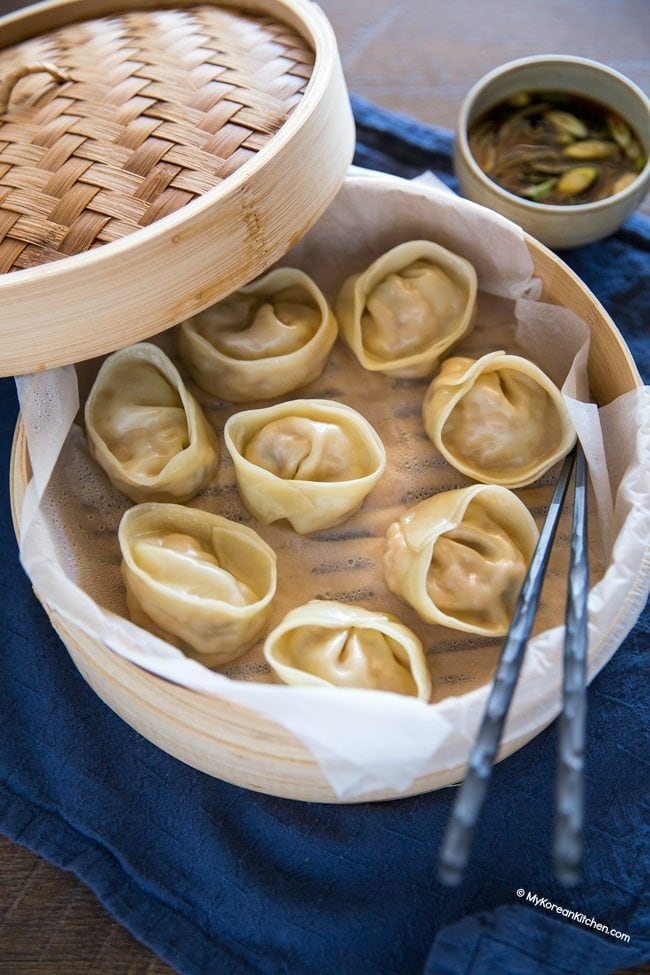
Koreans also often eat mandu on New Year’s day – Typically in a soup (often with rice cakes). Though, I think I prefer my mandu in a pan fried form for the crunchy texture. It’s even tastier when it’s coated with Korean sweet and spicy sauce.
Considering how easy it is to buy instant / ready to eat / frozen mandu from a grocery store, it requires some effort to make mandu / dumplings at home. But, homemade mandu tastes genuine! You know what I’m talking about, right?
Also, Kimchi mandu is another great way to use up some of your ageing Kimchi. (Check here if you’re looking for more recipes with kimchi!
Anyway, I hope you try my Kimchi mandu recipe soon!
P.S. Don’t forget to serve your mandu with my epic dumpling dipping sauce! They are the best combination!
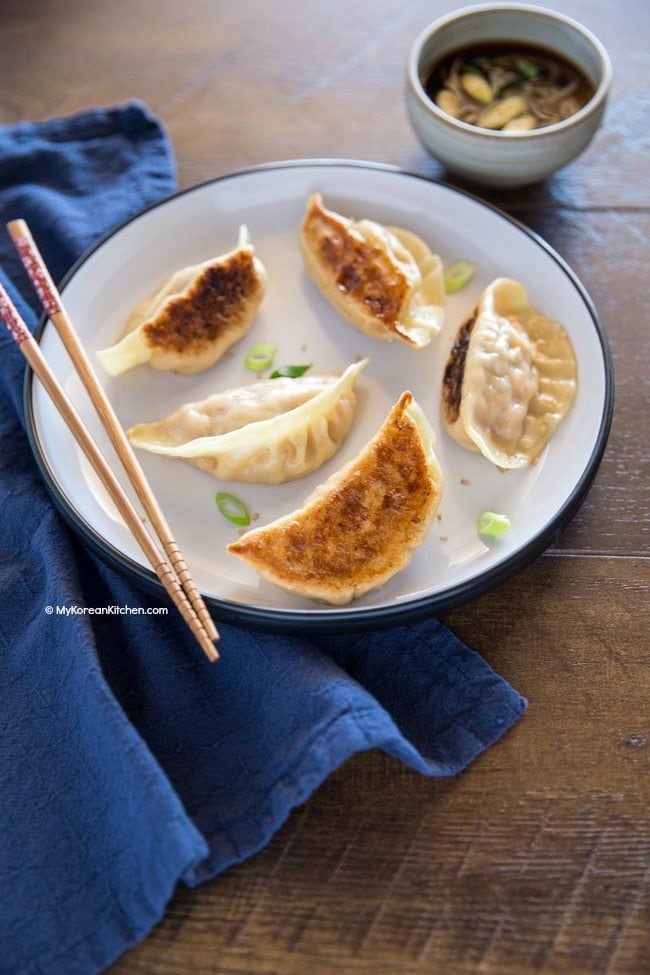
Ingredients for Kimchi Mandu / Kimchi Dumplings (for 25 pieces)
Dumpling skin
- 25 dumpling wrappers (large)
- Some water in a small bowl (to help with sealing the wrapper)
Dumpling fillings
- 1 and 1/2 cups kimchi (about 2 weeks+ old Kimchi), finely chopped (*see note)
- 250g / 8.8 ounces tofu (firm), minced (*see note)
- 200g / 7 ounces mung bean sprouts, parboiled and finely chopped (*see note)
- 130g /4.6 ounces minced pork (or beef), excess water / blood removed with kitchen paper towel
- 1/2 onion (50g / 1.7 ounces), finely chopped
- 10g / 0.3 ounces garlic chives, finely chopped
- 1 egg
- 1 tsp fine sea salt
- 1 tsp sesame oil
- 1/2 tsp minced garlic
- A few sprinkles of ground black peppers
Others
- Some cooking oil (I used rice bran oil)
- 1/4 cup water to use in pan frying (This is one batch use, so if you’re cooking in multiple batches, you will need more water.)
*1 Tbsp = 15 ml, 1 Cup = 250 ml
How to Make Kimchi Mandu / Kimchi Dumplings
1. Combine and mix the filling ingredients in a mixing bowl. (I used my hand to mix.)
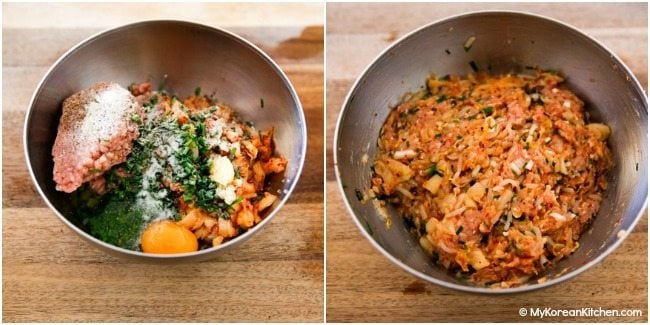
2. Place a dumpling wrapper on your palm and add the filling in the centre of the wrapper. Dip your finger in the water and lightly wet the edge of the dumpling wrapper. Seal the wrapper then place it on a non-stick flat surface. (I’m still a newbie when it comes to folding dumplings, so here is an awesome video instruction on “6 ways to fold a dumpling“. Don’t get intimidated by it if yours don’t look pretty at first. It takes some practice to make them pretty. 🙂 )
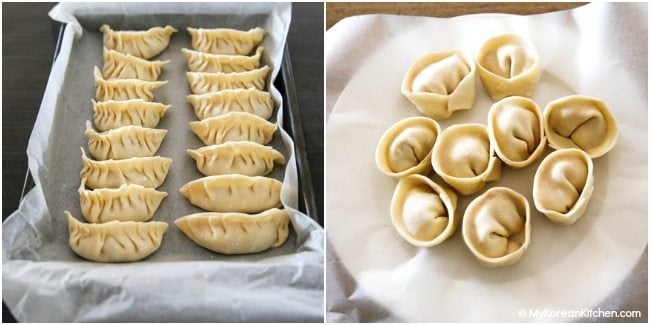
3. Repeat step 2 until you use up the remaining ingredients.
4. Cook mandu per your preference.
Pan fried mandu
In a well heated pan, add some cooking oil. Place some mandu and cook over medium high heat until the bottom of the mandu is golden brown (2 to 3 mins). Reduce the heat to medium to medium low. Add the water (1/4 cup) and put the lid on to cook with the steam. This will ensure the meat is thoroughly cooked without burning. Your mandu should be ready to eat when most of the water disappears in the pan (in about 5 mins).
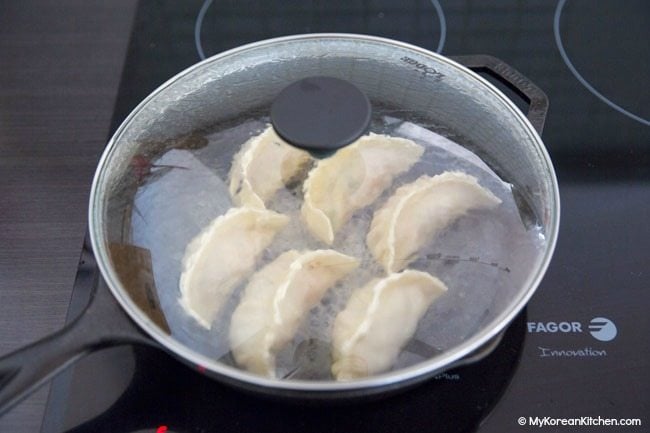
Steamed mandu
Place some non-stick materials (e.g. cabbage leaves or baking paper) on a steamer and place the mandu in it. Make sure the mandu are not touching each other. Put the lid on. Place the steamer over rolling boiling water (in a sauce pan) and cook the mandu for 15 to 20 minutes on medium low heat.
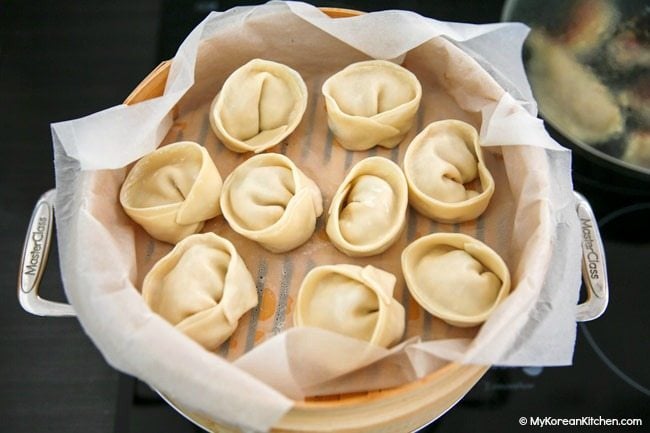
5. Serve the mandu on a plate while still hot and with Korean dumpling sauce.
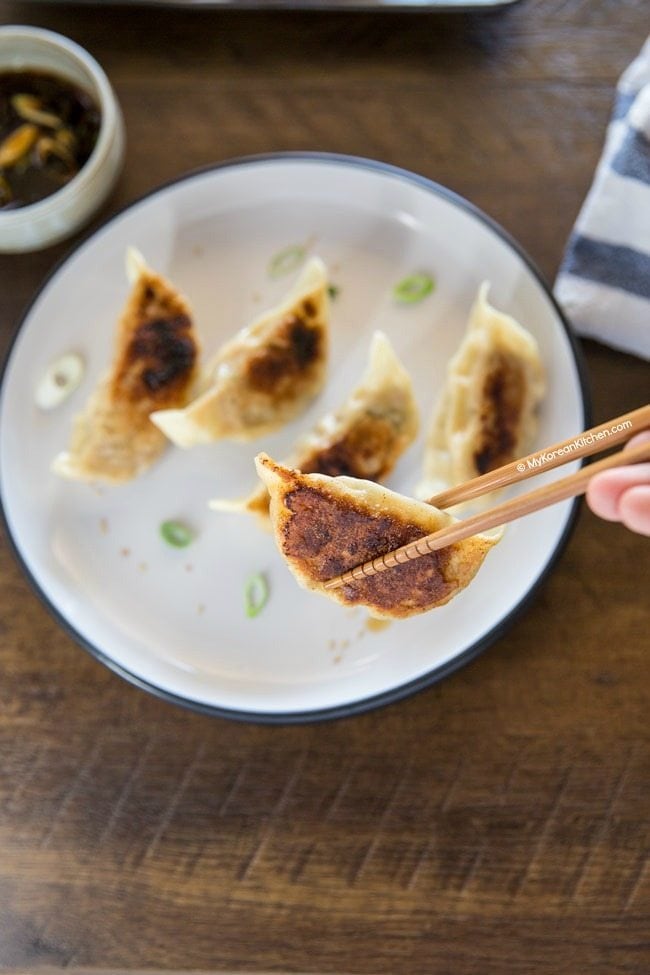
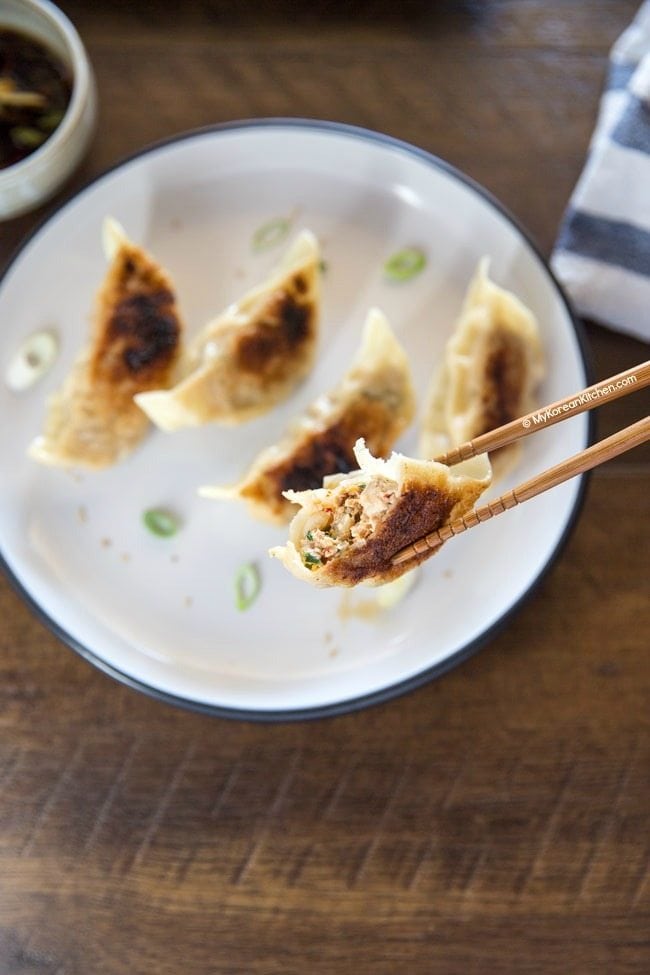
Note
- Kimchi, tofu and mung bean sprouts naturally contain lots of water. Excess water should be removed from these ingredients. Otherwise, it can tear the dumpling wrappers while you’re still assembling. I typically use this type of cotton cheese cloth but this type of muslin bag can be convenient to use as well. Reminder – Kimchi can stain these cloths.
- If you don’t like using tofu, you can add more pork / beef instead. Likewise, if you want a vegetarian version, you can add more tofu instead of using pork / beef.
How to Freeze Unused Dumplings
I haven’t tried freezing any homemade dumplings / mandu as I often experience a mandu shortage not surplus. However, this is what typical Korean ladies do.
If you are going to freeze, it’s best to steam them first. “Steam (per step 4 above) – Cool them down on a tray – Put the tray in the freezer for about 30 mins to harden – Take them out – Put the partly frozen mandu into a ziploc or equivalent plastic bag”. Store there until needed. (Probably best to consume within a month or so.)
Love Korean food? Browse lots more Korean recipes from my easy Korean recipe collections. And subscribe to my newsletter and follow along on Facebook, Pinterest and Instagram for all of the latest updates.
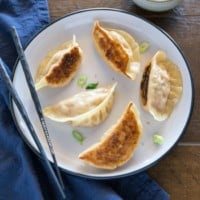
Kimchi Mandu (Kimchi Dumplings)
Ingredients
DUMPLING SKIN
- 25 dumpling wrappers (large)
- Some water in a small bowl (to help with sealing the wrapper)
DUMPLING FILLINGS
- 1 1/2 cups kimchi (about 2 weeks+ old Kimchi), finely chopped (*see note)
- 250 g tofu (firm) (8.8 ounces), minced (*see note)
- 200 g mung bean sprouts (7 ounces), parboiled and finely chopped (*see note)
- 130 g minced pork (or beef) (4.6 ounces), excess water / blood removed with kitchen paper towel
- 1/2 onion (50 g / 1.7 ounces), finely chopped
- 10 g garlic chives (0.3 ounces), finely chopped
- 1 egg
- 1 tsp fine sea salt
- 1 tsp sesame oil
- 1/2 tsp minced garlic
- A few sprinkles ground black peppers
OTHERS
- Some cooking oil (I used rice bran oil)
- 1/4 cup water to use in pan frying (This is one batch use, so if you’re cooking in multiple batches, you will need more water.)
Instructions
- Combine and mix the filling ingredients in a mixing bowl. (I used my hand to mix.)
- Place a dumpling wrapper on your palm and add the filling in the centre of the wrapper. Dip your finger in the water and lightly wet the edge of the dumpling wrapper. Seal the wrapper then place it on a non-stick flat surface. (I’m still a newbie when it comes to folding dumplings, so here is an awesome video instruction on “6 ways to fold a dumpling“. Don’t get intimidated by it if yours don’t look pretty at first. It takes some practice to make them pretty.)
- Repeat step 2 until you use up the remaining ingredients.
- Cook mandu per your preference.PAN FRIED MANDUIn a well heated pan, add some cooking oil. Place some mandu and cook over medium high heat until the bottom of the mandu is golden brown (2 to 3 mins). Reduce the heat to medium to medium low. Add the water (1/4 cup) and put the lid on to cook with the steam. This will ensure the meat is thoroughly cooked without burning. Your mandu should be ready to eat when most of the water disappears in the pan (in about 5 mins).STEAMED MANDUPlace some non-stick materials (e.g. cabbage leaves or baking paper) on a steamer and place the mandu in it. Make sure the mandu are not touching each other. Put the lid on. Place the steamer over rolling boiling water (in a sauce pan) and cook the mandu for 15 to 20 minutes on medium low heat.
- Serve the mandu on a plate while still hot and with Korean dumpling sauce.
Notes
Nutrition Info (per serving)
The nutrition information shown is an estimate provided by an online nutrition calculator. It should not be considered a substitute for a professional nutritionist’s advice.
